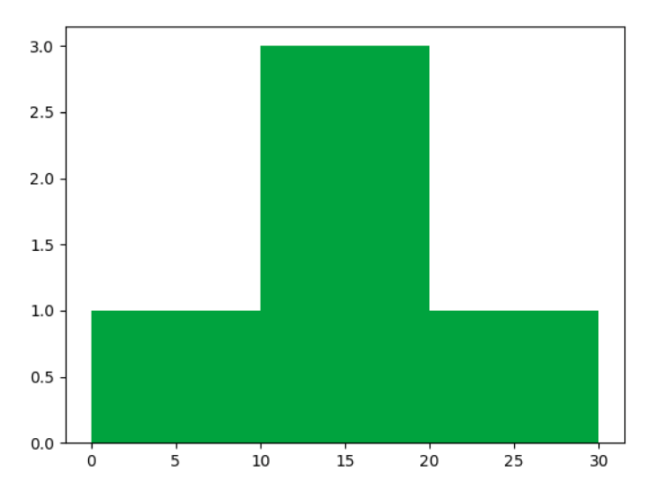NumPy 直方图是数值数据分布的图形表示。使用 histogram() 和 plt() 等函数,我们可以创建和绘制直方图。
我们将仔细研究直方图以及如何在 NumPy 中创建和绘制它们。
NumPy 直方图
NumPy 有一个内置函数 histogram(),它将数据数组作为参数。
在直方图中,一个“箱”(bin)是代表一组数据的数值范围。bin 是一个可选参数。
让我们看一个例子。
import numpy as np
# create an array of data
data = np.array([5, 10, 15, 18, 20])
# create bin to set the interval
bin = [0,10,20,30]
# create histogram
graph = np.histogram(data, bin)
print(graph)输出
(array([1, 3, 1]), array([ 0, 10, 20, 30]))
在此示例中,我们使用了 histogram() 函数来计算数据的频率分布。我们传递了两个参数:data 和 bin。
histogram() 函数返回一个包含两个数组的元组:
- 第一个数组包含每个 bin 内数据的频率计数,
- 第二个数组包含 bin 的边界。
从结果输出中,我们可以看到:
- 在 data 数组中,只有 **1** 个数据点(即 **5**)落在 **0** 和 **10** 的 bin 边界之间。
- **3** 个数据点(即 **10、15、18**)落在 **10** 和 **20** 之间,
- **1** 个数据点(即 **20**)落在 **20** 和 **30** 之间。
示例:NumPy 直方图
import numpy as np
# create an array of data
data = np.array([1, 2, 3, 4, 5, 6, 7, 8, 1, 2, 3])
# create bin to set the interval
bin = [0, 5, 10]
# create histogram
graph = np.histogram(data, bin)
print(graph)输出
(array([7, 4]), array([ 0, 5, 10]))
在这里,histogram() 函数返回一个数组元组。分析输出,data 数组中有 **7** 个数据点落在 **0** 和 **5** 的 bin 边界内,有 **4** 个数据点落在 **5** 和 **10** 之间。
绘制直方图
我们可以使用 plt() 函数来绘制直方图返回的数值。
plt() 是 Matplotlib 提供的函数。要使用 plt(),我们需要导入 Matplotlib。
让我们看一个例子。
import numpy as np
from matplotlib import pyplot as plt
# create an array of data
data = np.array([5, 10, 15, 18, 20])
# create bin to set the interval
bins = [0,10,20,30]
# create histogram
graph = np.histogram(data, bins)
print(graph)
# plot histogram
plt.hist(data, bins)
plt.show()输出
(array([1, 3, 1]), array([ 0, 10, 20, 30]))

在上面的示例中,我们使用了 histogram() 函数来计算数据的频率分布,然后使用 matplotlib 库中的 plt.hist() 函数绘制了生成的直方图。
